Occupational well-being is more than a pressing issue—it’s a global crisis. Data from Gallup indicate that 44% of workers worldwide reported experiencing workplace stress the previous day, an all-time high.1 A mere 33% of global workers say they’re thriving in their well-being.1 Considering the significance of well-being to talent worldwide, it should be a top priority of organizations and leaders.
But well-being means different things to different people. How does the interpretation of well-being vary across cultures? Who is responsible for it, and what role does leadership play? We know that leaders’ impact on employee well-being is substantial, but what type of leader is most likely to prioritize well-being?
To explore these questions, we look to our authorized Hogan distributors, who are experts in their respective talent markets around the world. Keep reading to find out how these contributors helped us examine well-being trends and issues in their regions, as well as their perspectives about characteristics of leaders who are likely to support employee well-being.
What Is Occupational Well-Being?
Occupational well-being is how someone’s working life affects their sense of purpose and meaning. This is inseparable from the other dimensions of well-being: physical, emotional, social, and spiritual. Other factors related to occupational well-being include work environment, job satisfaction, engagement, and workplace culture.
“Occupational well-being needs to be understood within the political, economic, social, and technological realities of a country or region,” noted Jani Wiggett, director at JVR Psychometrics.
Because the topic is context specific, not everyone thinks of “occupational well-being” the same way. Most of our contributors named “balance” as key to enabling employees to thrive, but they differed in what that means. Some emphasized physical safety, hours worked, or compensation, while others emphasized efficiency, relationships with colleagues, and alignment with workplace culture.
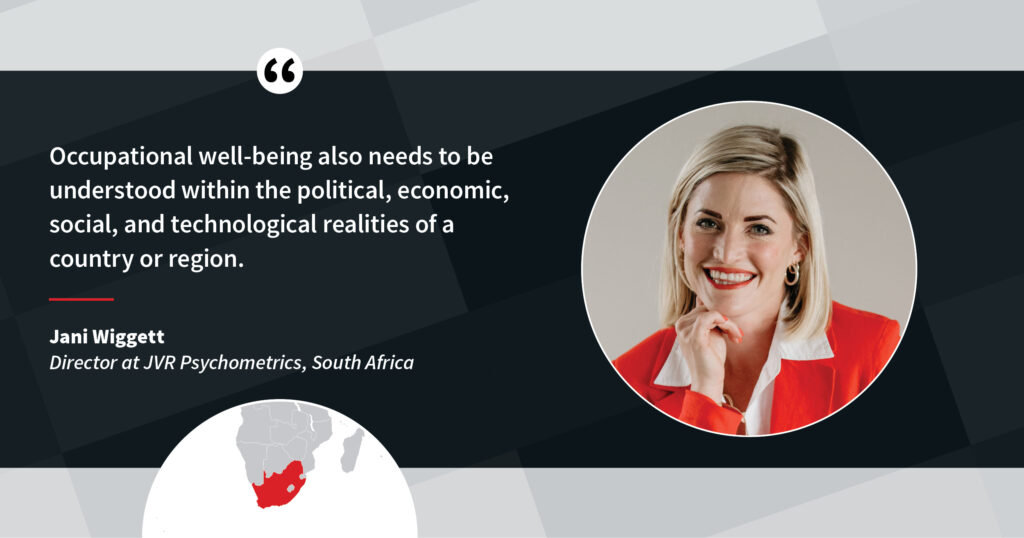
No single objective definition of occupational well-being exists. However, we can propose a working definition based on some general themes that arose during our research:
Occupational well-being can be described as a state of contentment and fulfillment regarding work. This feeling arises from finding meaning in one’s work, feeling valued and respected by colleagues and leaders, having access to resources and opportunities for personal and professional growth, and maintaining work-life balance. Occupational well-being can contribute to higher levels of productivity, better overall well-being, and greater satisfaction with one’s life and career.
Keep the flexibility of the term in mind as you continue reading.
What Influences Perceptions of Occupational Well-Being?
Perceptions of occupational well-being vary globally. While the factors influencing these perceptions are diverse, a few are particularly key. From region to region, cultural norms, economic disparities, and regulations are major influences. Through our research, we also found that regional variations in work-life balance, or the degree of separation between personal and professional lives, shape attitudes toward well-being in the workplace.
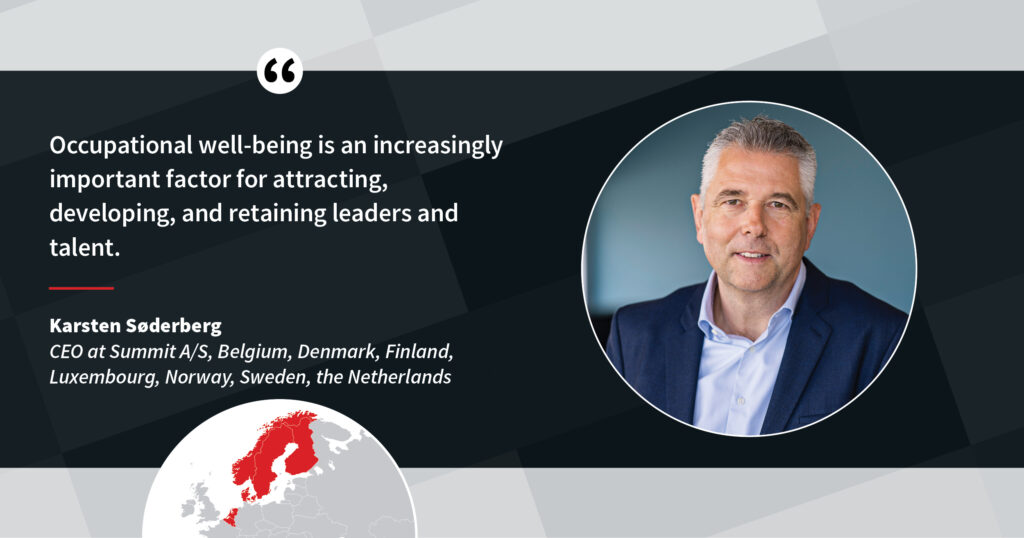
Cultural Impact on Employee Well-Being
The cultural impact on global well-being issues is hard to exaggerate. Occupational well-being is, in some regions, a widespread cultural expectation. About Scandinavia and Benelux, Karsten Søderberg, group CEO at Summit A/S, said, “The workforce increasingly values, focuses on, and expects an articulated position from organizations about occupational well-being, which is an increasingly important factor in attracting, developing, and retaining leaders and talent.”
The influence of cultural norms on well-being can vary according to global or local region, political or religious influences, or even industrial or organizational culture. For instance, the financial services sector in the United Kingdom differs culturally from other traditional British institutions. Another example is the worker-organization relationship in traditional Chinese culture; workers may be expected to demonstrate devotion to the organization, while the organization is expected to provide for its workers. “Chinese culture emphasizes relationships, and the organization has the responsibility to take care of its employees,” said Nancy Zhang, founder and CEO at Empower Leaders Consulting.
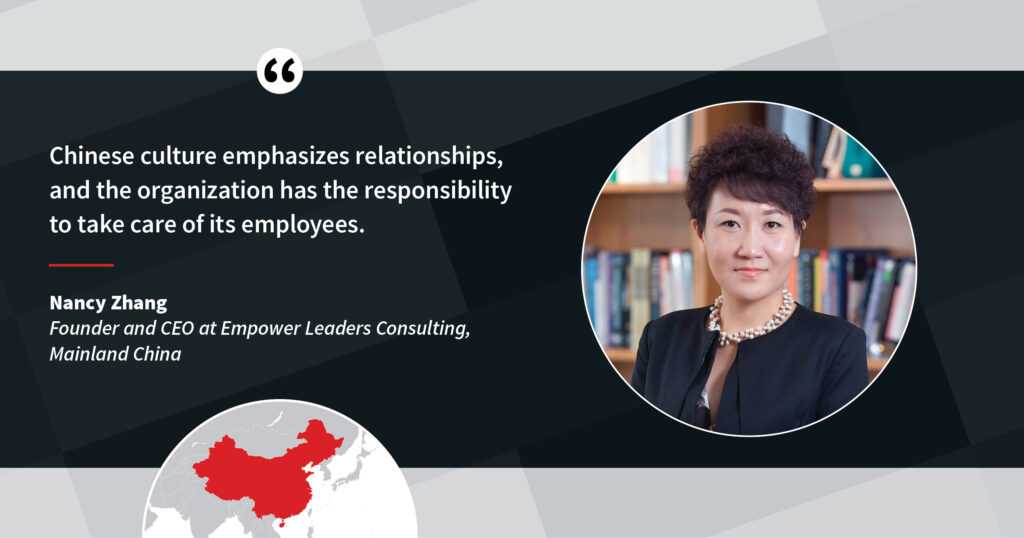
On the other hand, Germany has historically emphasized individual expertise and self-discipline in any job function. From a North American perspective, well-being is no longer considered secondary to work, with employees more focused than ever before on finding fulfilling work that promotes a lifestyle of health and wellness.
Economics has an impact on cultural attitudes toward occupational well-being. For workers in countries with huge regional economic disparities such as Brazil, occupational well-being might mean having any job at all. Similarly, in the extremely diverse country of South Africa, occupational well-being might mean access to food and shelter in one area or professional growth opportunities in another. Depending on cultural perspectives and the availability of work, people might place very little importance on occupational well-being and seek fulfillment in other areas of life.
Regulations for Occupational Well-Being
The regulatory impact on global well-being trends varies substantially by government or industry. Yet countries with established laws about occupational safety and health have not necessarily included psychosocial hazards in their definition of risk factors.2
Mexico has recently implemented regulations about occupational well-being, including psychosocial risks. According to Maria Victoria Zapata Guerrero, CEO at HRTools, “The influence of local regulations is substantial.” She described how Mexican organizations are required to maintain favorable working environments and a sense of belonging for employees. Organizations must comply with NOM-035, a 2019 standard from the Ministry of Labor and Social Welfare to prevent psychological risk factors in the workplace.3
While the perception in most global regions is that the responsibility for employee well-being is shared between worker and organization, the division of responsibilities and how organizations are held accountable differ. In Germany, organizations are supposed to implement processes to ensure employees do not work too many hours, but reporting those hours tends to be employees’ responsibility. In Greece, organizations must legally offer parental leave, but employees choose whether to exercise that opportunity.
Work-Life Balance
Another influence on the perception of employee well-being is work-life balance, or how much separation employees maintain between their personal life and professional life. Our contributors described two major factors that affect work-life balance. First, because of the sudden global shift to remote work during the COVID-19 pandemic, boundaries separating the personal and professional shifted and have remained in flux. Second, the higher the level of responsibility a person holds usually indicates less separation between work and personal life. Other factors here may include traditional values, organizational culture, tenure, lifestyle, and (of course) individual differences in personality.
Our contributors observed broad regional trends influencing work-life balance. In Greece, employees at state and traditional businesses typically maintain more separation, while those in multinational companies typically have less. In Germany, a higher education level corresponds to less work-life balance. In Scandinavia and Benelux, self-employed workers or small business owners also exercise less separation. For workers in the UK, the degree of work-life balance has improved significantly since the COVID-19 pandemic began. In the US and Canada, many workers are still trying to find balance in remote work environments. In South Africa, the combined impact of numerous economic factors has blurred the boundaries between personal and work lives.
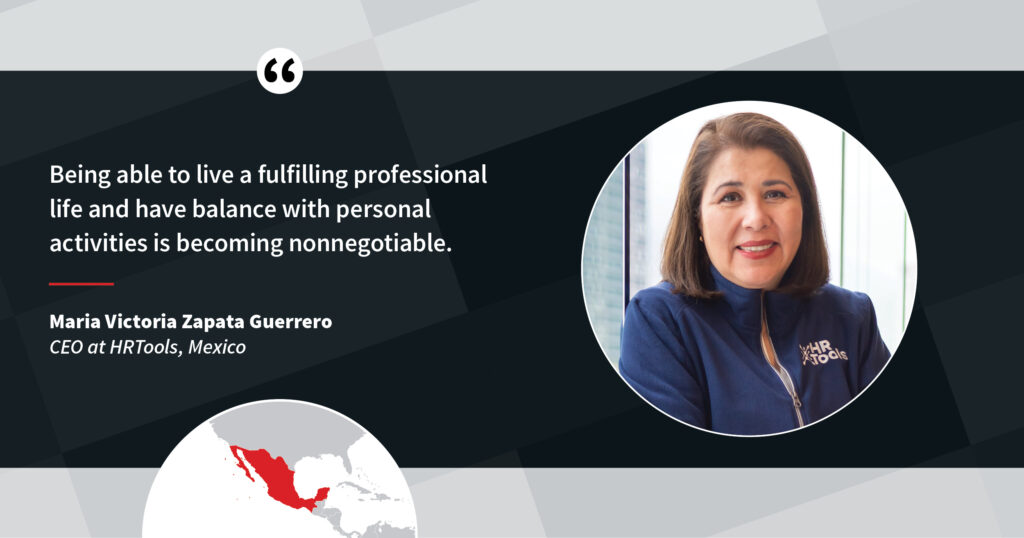
Employer Well-Being Initiatives
Whether mandated by regulation or not, organizations worldwide are actively responding to the growing expectations of employees for more initiatives aimed at supporting occupational well-being. These employer initiatives range broadly in their areas of focus.
Many work-life balance initiatives include time off and leave. Some examples include four-day workweeks, additional vacation days, reduced working hours, part-time arrangements, sabbaticals, parental leave policies, and support for childcare and eldercare.
Other common initiatives focus on flexibility in work schedule and location—for example, flexible work hours, hybrid work models, and work-from-home or work-from-anywhere options.
A third category of well-being initiatives focuses on physical and emotional well-being. Some examples of these provisions are health insurance coverage, wellness-related activities and perks such as nutrition or fitness programs, stress management and time management training, and mental health support services.
Finally, an increasing number of organizations are offering professional development opportunities, such as leadership development, executive coaching, management training, sponsorships, higher education, and trainings or certifications.
The well-being initiatives an organization chooses often vary by industry and location. For many, however, building an employer brand is a significant consideration. “Organizations are realizing the importance of occupational well-being for their employer brands,” said Jeremy Sutton, CEO at 3 Minute Mile. Brand also plays a role in employee retention. As organizations struggle to find and retain talent globally, employees’ public feedback about well-being initiatives is a factor in employer reputation.
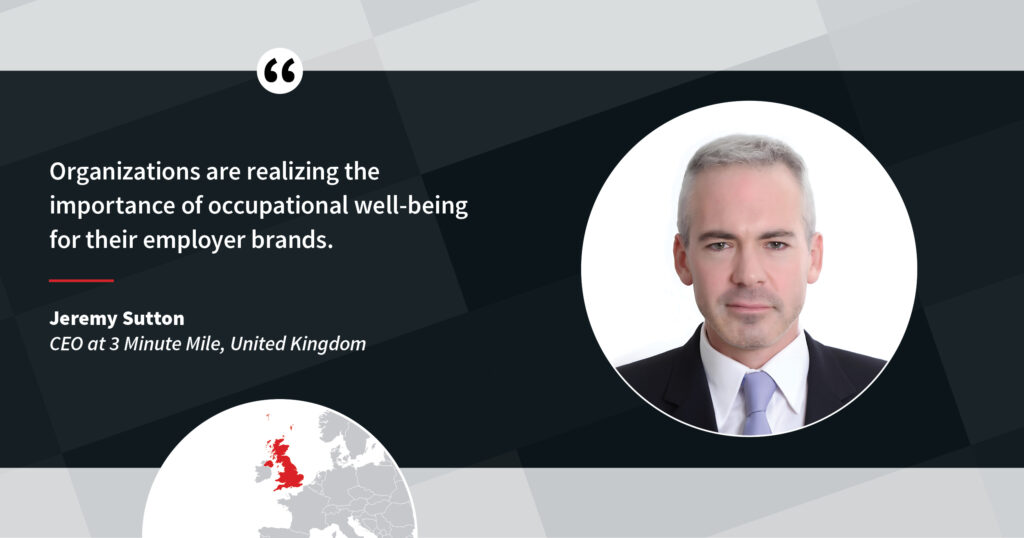
Leadership Responsibility
Unquestionably, leaders have a crucial role to play in ensuring the well-being of employees—and not just because of their role in deciding organizational benefits and perks. In a recent survey, 69% of respondents indicated that the impact their manager has on their mental health is equal to that of a romantic partner.5 Organizations can and should address the well-being needs of their employees by selecting and developing leaders who create environments that support occupational well-being.
Leadership Responsibility
Many leadership strengths concern socioemotional skills, not technical skills. Socioemotional skills include social ability, self-regulation, motivation, and other personality characteristics that affect worldview and behavior. Because leadership is the ability to build and maintain high-performing teams, how well a leader relates to and influences a team has far more impact on employee well-being than, for example, the number of programming languages in which the leader is proficient.
We find that certain Hogan Personality Inventory (HPI) characteristics tend to help leaders promote organizational well-being. The HPI is an assessment of personality strengths that can be linked to socioemotional skills. Backed by more than 40 years of validated research, the seven HPI scales measure everyday personality and provide data about how a person’s reputation is likely to seem at work.
In this section, we explore insights from our distributors, as well as our extensive research on the relationship between personality and performance, to identify crucial qualities of leaders who prioritize well-being.
Socioemotional Skills
Eight of our contributors mentioned the HPI’s Interpersonal Sensitivity scale as significantly related to a leader’s tendency to create an environment that prioritizes employee well-being. The Interpersonal Sensitivity scale provides insight about how well a leader perceives and understands the emotions, needs, and motivations of others. It involves being attuned to the subtle cues, both verbal and nonverbal, expressed by others. Leaders who score higher on this scale seem friendly, empathetic, diplomatic, easygoing, tactful, perceptive, and tolerant and are more likely to establish and maintain meaningful connections with others. “People who are naturally caring and sensitive will likely take care of the team and lead with compassion,” explained Dongwei (Vivian) Yang, director of tool-based solutions at Mobley Group Pacific.
“Leaders with high Interpersonal Sensitivity scores are likely concerned about the well-being of others and may want to nurture relationships by fostering trust, goodwill, and the creation of a cooperative team,” concurred Ryan Rush, PhD, corporate solutions consultant at Hogan.
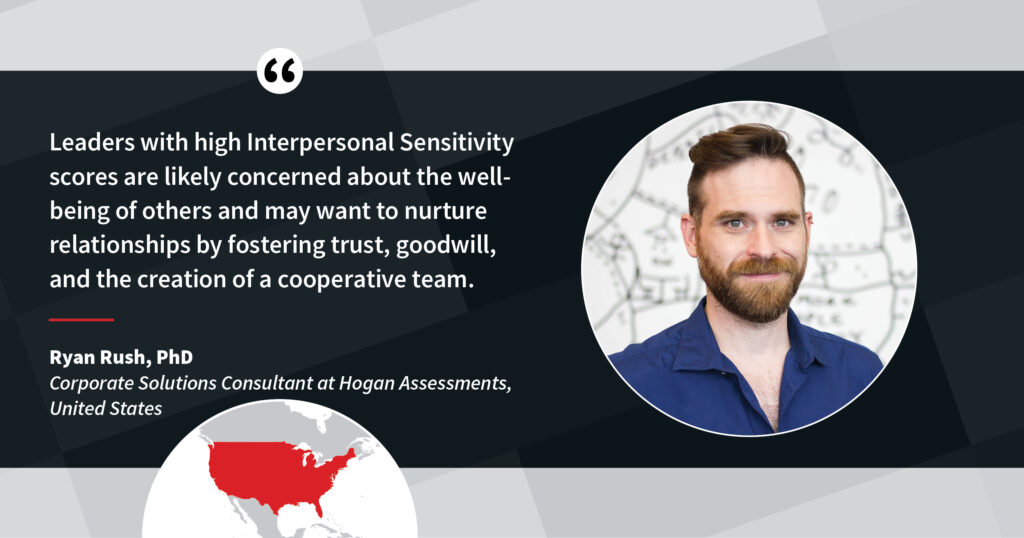
The second HPI scale that our contributors identified as most important to a leader’s likelihood to prioritize employee well-being is Inquisitive. An inquisitive leader is naturally curious and more likely to seek employee feedback and explore innovative solutions. A leader scoring mid-to-above average on both Inquisitive and Interpersonal Sensitivity may be more likely to foster an environment of open communication, continuous learning, active listening, empathy, and psychological safety.
Many contributors noted various implications of leaders’ Ambition and Adjustment scores. The Ambition scale measures a person’s drive, motivation, and desire to achieve success and advancement in their work and career. A higher score indicates a greater likelihood the leader will take charge, set challenging goals, and be competitive. While a leader with these qualities potentially could cause stress or intimidation, the right balance of energy and drive could also catalyze engagement and productivity.
“We know that both sustainability and continuous improvement are essential to remain competitive,” said Wiggett. “Well-being initiatives could be a core aspect of corporate achievement. Without excellent and productive employees, it would not be possible to remain competitive or be successful. In addition, to attract and retain talent it is important to create an environment in which they can perform.”
According to our executive benchmark data, scores on the Ambition scale vary by region more than any other HPI scale. Executive Ambition scores in East Asia (China, Hong Kong, Japan, Mongolia, South Korea, and Taiwan) tend to fall on the lower end of average, suggesting these leaders are supportive of their teams and encourage group harmony. Ambition scores of executives in Canada and the US tend fall on the highest end of average, indicating a drive for results.
The Adjustment scale measures a person’s emotional stability and the degree to which they appear composed under pressure. Many contributors noted average or high Adjustment scores would positively affect employee well-being because the leader would be able to manage change and challenges without adding stress to the team. Leaders with higher Adjustment scores may also be more likely to mitigate their dark-side derailers. Moderate scores may suggest leaders who listen to criticism without becoming defensive and who are receptive to learning from their mistakes. These qualities can be valuable in establishing an environment of psychological safety.
But what do profiles of most global executives tell us about leader adjustment? Our benchmark data show Adjustment as the HPI scale that most often appears the lowest in executive profiles globally, falling on the lower end of average. Leaders who score low on adjustment may struggle to manage stress effectively and seem moody or easily irritated. The role of emotional regulation in occupational well-being is significant, both for the leader and the employee. Organizations that provide support and development opportunities to leaders with lower Adjustment scores will likely see a better outcome in overall employee engagement and well-being.
Notably, these characteristics are significant to a leader’s emotional intelligence.
Emotional Intelligence
Emotional intelligence (EQ), or the ability to identify and manage one’s own and others’ emotions, can affect a leader’s likelihood and ability to create a work environment that prioritizes employee well-being. Hogan measures EQ in terms of three core competencies: emotional perception, emotional control, and emotional sharing.
Emotional perception encompasses the degree to which a person seems in touch with their emotions and can decipher the emotions of others. Emotional control refers to the capability to regulate and influence one’s own and others’ emotional states, respectively. Finally, emotional sharing represents the degree to which a person communicates desired emotional states and responds to the emotional states of others.
These abilities can make leaders effective in managing stress and instilling confidence in employees, building collaborative teams, creating a healthy organizational culture, and making sensitive and empathy-driven decisions that benefit employee well-being.
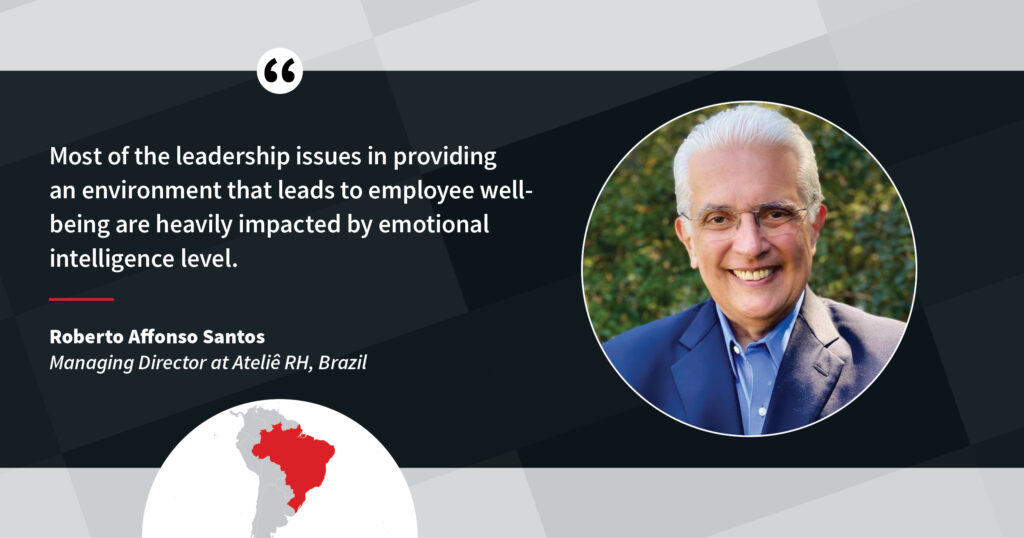
Arguably, EQ is necessary for any human interaction. Leaders accomplish work by means of team productivity. A leader who cannot manage their own or others’ emotions may create an environment that fosters stress, toxicity, or burnout. Thus, the ability to build and maintain a high-performing team requires a leader to have a nuanced understanding of emotional intelligence. “A leader could get the best version of her team through high EQ,” Zapata Guerrero said.
EQ skills also influence leader decision-making. High emotional intelligence helps a leader understand the needs of employees and make choices to support their occupational well-being individually or as a team.
“Leadership is not only about ‘caring’ or showing empathy but also that effective leaders are able to objectively solve problems using data and facts without impulsively reacting to emotional stimuli. They can also adapt to change, remain optimistic about the future, and emotionally calm people down,” Wiggett explained.
Humility
Humility concerns displaying modesty, acknowledging limitations, and seeking feedback. What can a leader’s humility tell us about their tendency to create an environment that prioritizes employee well-being? The short answer is lots.
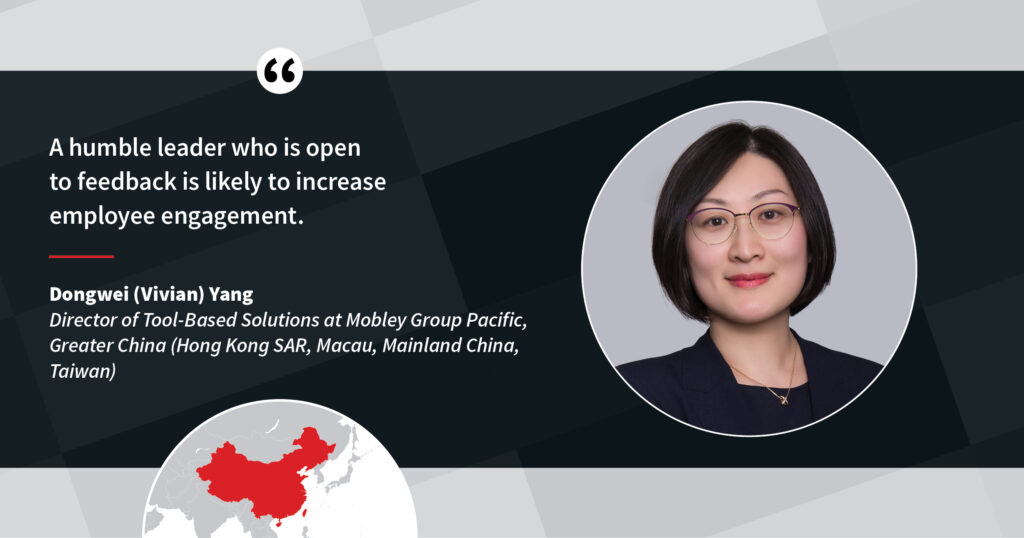
Humility is related to high scores in HPI Adjustment, Interpersonal Sensitivity, and Prudence. High scorers tend to seem self-accepting, kind, and modest about their work. Having noted previously the implications of high Adjustment and Interpersonal Sensitivity, high Prudence scores would indicate a leader who is conscientious and dependable. Our executive assessment data show a wide regional variance in Prudence scores. On average, executives in Germany score in the low range, while executives in Mexico have an average Prudence score that is 29 points higher, nearly into the high range.
Humble leaders excel at balancing the needs of individuals or teams with organizational needs. “Humility allows the leader to set aside personal wants and needs to see what is important for others. Leaders must acknowledge when their chosen style is not working, solicit feedback, and adapt to better engage others around them,” said Sutton. Humble leaders have an open mindset to understand what is needed to create occupational well-being. They are open to feedback to improve employee engagement and are consequently likely to build an environment where people have the freedom to share their views safely.
How Can Organizations Prioritize Employee Well-Being?
Employee well-being is largely dependent on leader personality and behavior. So how can employers apply this knowledge to prioritize employee well-being? The solution is multifaceted: employers must first understand the organization’s context, then select and develop leaders accordingly.
Understand Organizational and Team Culture
Just as regional cultures vary across the globe, organizational and team cultures are all unique. Employers must understand employee perceptions and needs, as well as organizational and team dynamics. For example, in a competitive and challenging industry, a company may benefit from leaders who demonstrate empathy and compassion, placing a high priority on the well-being of their employees. In situations where employees hesitate to voice their opinions or fear making mistakes, they can benefit from a leader who actively fosters an inclusive and secure environment with intention. When leaders are connected to the needs of their employees, they can begin taking strategic steps toward organizational well-being goals.
Select Leaders with Employee Well-Being in Mind
To select leaders with employee well-being in mind, considering personality is crucial. Well-validated personality assessments, such as those published by Hogan, can help organizations identify leaders who have the specific skills needed to initiate or advance organizational goals and whose values will contribute to a culture of well-being.
Hogan has assessed more than 11 million people around the world and has the largest database of global leadership performance data. What this means is that we can tell you what it takes to succeed in any industry and in any job role—anywhere in the world.
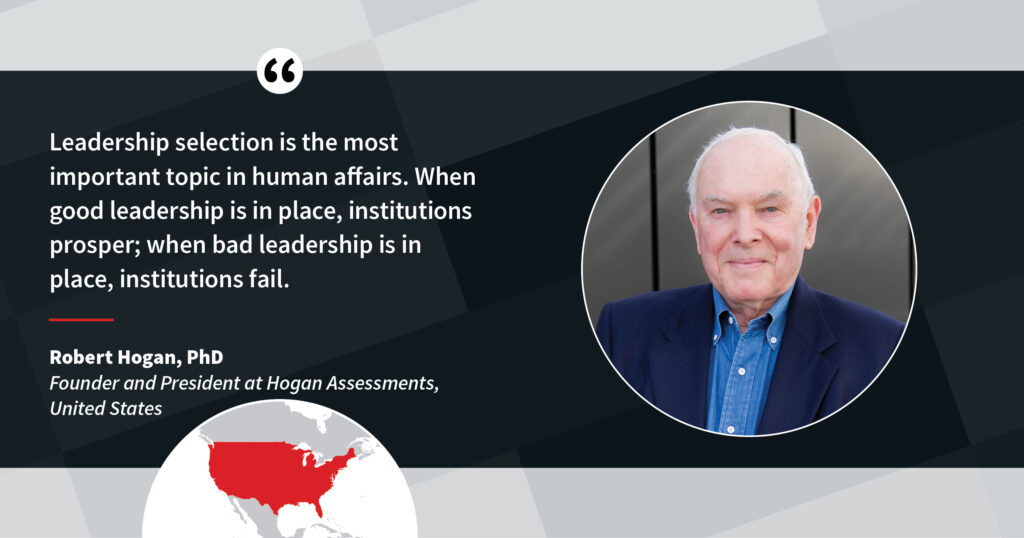
To predict leadership performance, our assessments measure personality from three perspectives: the bright side, the dark side, and the inside. The bright side of personality, evaluated using the Hogan Personality Inventory, or HPI, describes the strengths a leader is likely to use to achieve career goals, build effective teams, and develop future leaders. The dark side of personality is evaluated using the Hogan Development Survey (HDS) and describes the counterproductive personality characteristics that can interfere with team relationships and derail careers. Lastly, the Motives, Values, Preferences Inventory (MVPI) assesses the inside of personality. This consists of the core values, motives, and unconscious biases that drive leader behavior and shape both team and organizational culture. Considering the bright side, the dark side, and the inside together can offer insight into every facet of leadership potential.
Develop Leaders to Prioritize Well-Being
For leaders to achieve their highest potential, developing strategic self-awareness is key. When we say strategic self-awareness at Hogan, we mean something specific. Strategic self-awareness includes understanding your strengths and limitations and understanding how your performance compares with that of others.6 Self-awareness alone lacks that second part. A leader who is strategically self-aware exercises situational judgment about their behavioral strengths and limitations in social contexts.
“Being self-aware makes leaders more sensitive to their impact on others and to others’ feedback, which would likely contribute to their understanding of their employees’ needs and requirements,” said Zhang. Kostas Zoulias, human capital consulting director at ICAP People Solutions, shared a similar thought: “Strategic self-awareness helps leaders understand the impact of their behaviors on employees’ well-being, which also helps them prioritize relevant activities.” These perspectives epitomize why strategic self-awareness is critical for leaders to create work environments that prioritize employee well-being.
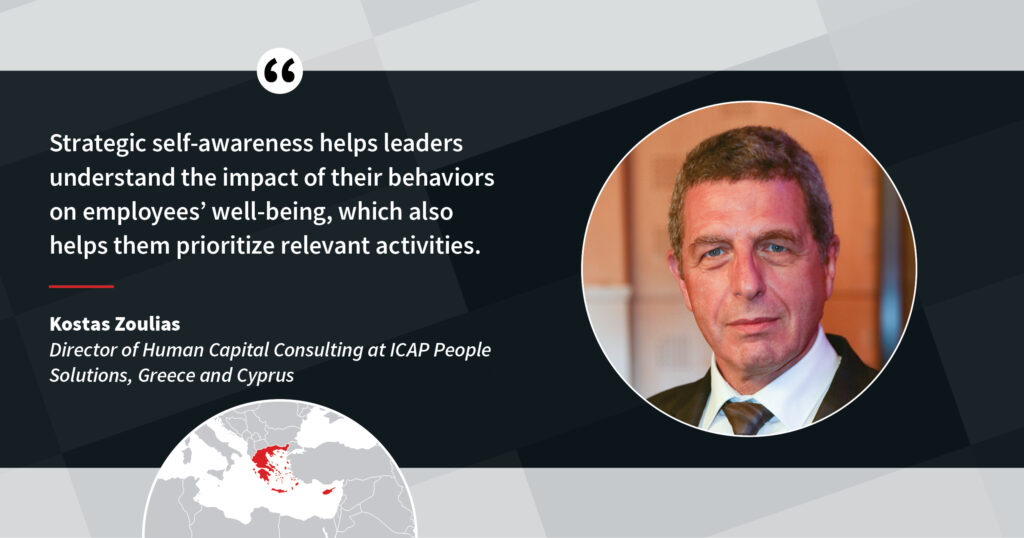
To prioritize employee well-being effectively, leaders must understand how their personalities influence their behavior. Intentionally emphasizing some skills and de-emphasizing others can help leaders communicate well, make objective decisions, and seem calm, reliable, and trustworthy to employees. Such leaders can create a positive, professional work environment, where employees feel heard, respected, and valued. A culture of inclusion and belonging strongly supports employee well-being and overall organizational success.
Roberto Affonso Santos, managing director at Ateliê RH, made the point that strategic self-awareness also helps limit unconscious bias in leaders. “It is a critical element for the leader to separate their values from the organizational values and avoid judging team members based on bias lenses,” he said.
Leaders need to understand how their behavior impacts their reputation—and how their reputation impacts their relationships. By adapting their strengths and limitations to be versatile in their leadership approach, leaders can create positive relationships with employees and foster a culture of growth.
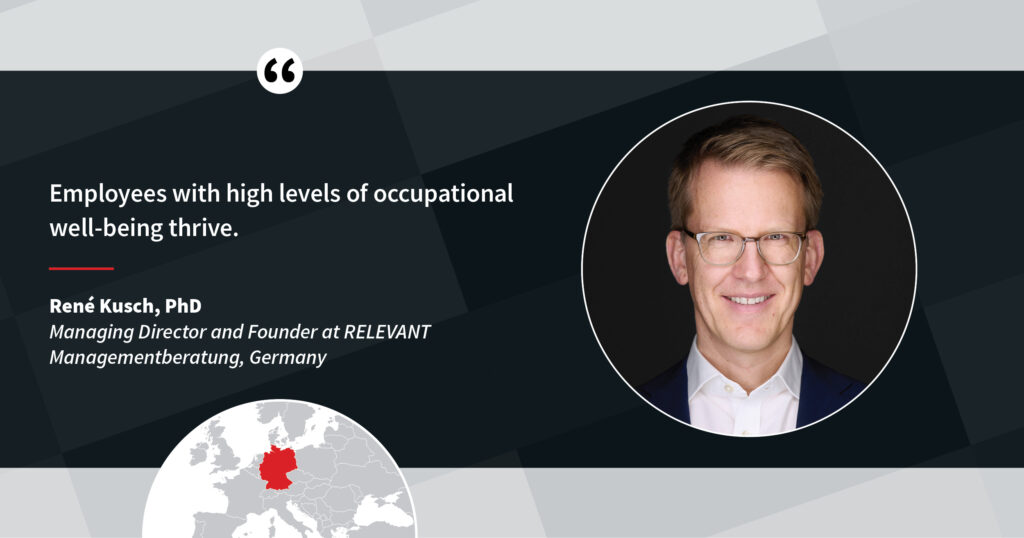
Leading With Well-Being in Mind
Of all the elements that impact occupational well-being, including culture, regulations, employer initiatives, and employee expectations, leadership likely has the most direct effect. After all, in the US, 65% of workers say that their immediate superior is “the worst and most stressful part of their lives.”7 Leaders who are best able to build and maintain high-performing teams are often excellent communicators with resilience, empathy, and an open mindset. These leaders act like facilitators, dedicating themselves to creating optimal environments where employees can succeed.
“Employees with high levels of occupational well-being thrive,” said René Kusch, PhD, managing director and founder at RELEVANT Managementberatung.
Driving team performance requires intent focus on occupational well-being—not just because it’s right, but because it’s the most effective way to lead. This is a delicate balance, and that’s why prioritizing occupational well-being is and will continue to be a key factor in distinguishing the most effective leaders.
Despite all of the attention on improving workplace well-being, one group has been largely ignored: the leaders who are often held responsible for it.
Find out how stress is affecting your leaders.
Contributors
Special thanks to Brandon Ferrell, PhD, Hogan’s director of product innovation, and his team for providing insight into the leadership characteristics associated with creating a culture of well-being.
We also extend our appreciation to these regional experts who contributed their knowledge and insights to this article (listed in order of appearance):
Jani Wiggett, director at JVR Psychometrics (South Africa)
Karsten Søderberg, group CEO at Summit A/S (Belgium, Denmark, Finland, Luxembourg, Netherlands, Norway, Sweden)
Maria Victoria Zapata Guerrero, CEO at HRTools (Mexico)
Nancy Zhang, founder and CEO at Empower Leaders Consulting (Mainland China)
Jeremy Sutton, CEO at 3 Minute Mile (United Kingdom)
Dongwei (Vivian) Yang, director of tool-based solutions at Mobley Group Pacific (Hong Kong SAR, Macau, Mainland China, Taiwan)
Ryan Rush, PhD, corporate solutions consultant at Hogan Assessments (United States)
Roberto Affonso Santos, managing director at Ateliê RH (Brazil)
Robert Hogan, PhD, founder and president of Hogan Assessments (United States)
Kostas Zoulias, human capital consulting director at ICAP People Solutions (Cyprus, Greece)
René Kusch, PhD, managing director and founder at RELEVANT Managementberatung (Germany)
References
1. Gallup. (2022). State of the Global Workplace: 2022 Report. Gallup. https://www.gallup.com/workplace/349484/state-of-the-global-workplace-2022-report.aspx
2. Chirico, F., Heponiemi, T., Pavlova, M., Zaffina, S., & Magnavita, N. (2019, July 11). Psychosocial Risk Prevention in a Global Occupational Health Perspective: A Descriptive Analysis. International Journal of Environmental Research and Public Health, 16(14), 2470. https://doi.org/10.3390/ijerph16142470
3. Treviño, F. (2020, November). MEXICO – NOM-035 on Psychosocial Risks Takes Effect. American Bar Association. https://www.americanbar.org/groups/labor_law/publications/ilelc_newsletters/issue-november-2020/nom-035/
4. Deloitte. (2021). The Deloitte Global 2021 Millennial and Gen Z Survey. Deloitte. https://www2.deloitte.com/xe/en/pages/about-deloitte/articles/millennialsurvey.html
5. Brower, T. (2023, January 29). Managers Have Major Impact on Mental Health: How to Lead for Wellbeing. Forbes. https://www.forbes.com/sites/tracybrower/2023/01/29/managers-have-major-impact-on-mental-health-how-to-lead-for-wellbeing/
6. Hogan, R., & Benson, M. J. (2009). Personality Theory and Positive Psychology: Strategic Self-Awareness. In Kaiser, R. B. (Ed.), The Perils of Accentuating the Positive (pp. 115–134). Hogan Press.
7. Hogan, R., & Sherman, R. A. (2022, May). Dark Leadership and the Fate of Organizations. In Lusk, D, & Hayes, T. L. (Eds.), Overcoming Bad Leadership in Organizations (pp. 17–28). Oxford University Press. https://doi.org/10.1093/oso/9780197552759.003.0002